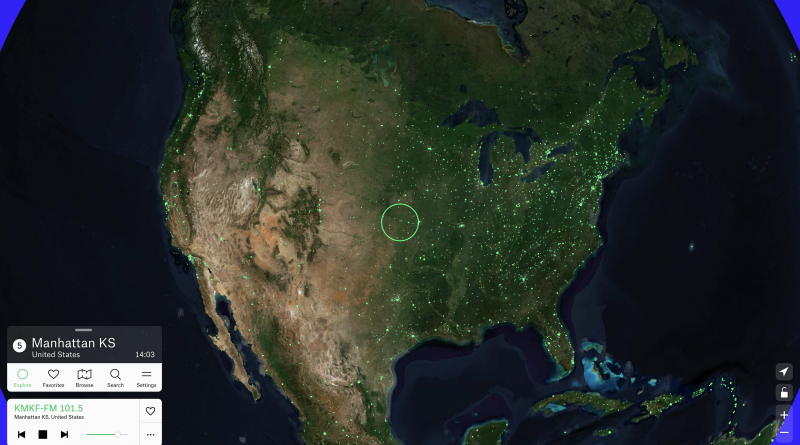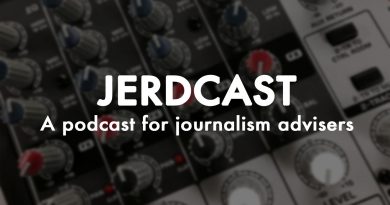Use ‘Radio Garden’ to inspire programming, develop cultural awareness
Services exist that allow student media programs to easily develop online radio stations, and doing so is worth consideration as most Americans regularly use radio. After all, Pew Research Center data indicates that since 2010 at least 83% of Americans listen to terrestrial radio weekly.
From a local perspective, radio provides powerful avenues for connection among community members. In fact, one-in-five U.S. adults get their local news from radio stations, and half of U.S. adults get any of their news via radio.
Through this medium, communities can be built. That’s crucial for civic engagement and developing social capital. However, it does more. It gives people a sense of belonging or “place.”
Media scholar Nikki Usher has researched how important this is in terms of both the work journalists do and the physical locations where journalism occurs.
Equally important is how “place” can influence identity and culture.
Political scientist Katherine Cramer’s work highlighted that people see themselves from a place-first perspective, and that same view shapes what they think about others and the news they consume. Additionally, research by Andrea Wenzel found that “place influenced how residents prioritized issues.”
As such, local radio creates an insightful representation of a given community.
With this in mind, listening to the radio sheds light on the people and places being reached by considering the type of music and other programming being sent out over the airwaves, and that cues up impactful learning opportunities.
To capitalize on the rich examples of humanity emanating from stations around the world, educators need a one-stop shop for audio programming, and such a place exists thanks to technology.
Rather than randomly searching the Internet for different radio stations’ websites, just take a spin around the Radio Garden.
This service allows listeners to tune into almost any radio station in any country around the world, and it supports this through a 3D user interface reminiscent of Google Earth.
“It’s like having a shortwave radio to listen to various broadcasts around the world — only far more powerful,” Lonnie Brown wrote for The Ledger in Lakeland, Florida.
It’s a simple, yet elegant, application that transports listeners around the world and into unique communities, and it also evokes a simpler time when consuming information, news, and entertainment was a slower endeavor that didn’t require drinking from a proverbial fire hose of content.
Launched in 2016, Radio Garden was created by Jonathan Puckey, who is based in the Netherlands, with support from the Netherlands Institute of Sound and Vision, and part of its goal is to “investigate the important role radio plays in identity.”
“Radio is at its best when it represents local tastes and cultures,” Puckey said in an interview with The Guardian. “The beauty of radio is that while radio signals themselves cross borders, radio studios have very fixed locations and are therefore always regional in nature.”
Student media advisers and educators can leverage this tool in various ways to benefit their students.
Programming Inspiration
For example, this service can be used to inspire student programming. By twirling the digital globe and listening in on a station, students can gather ideas for their podcasts, live streams, news shows, or even yearbooks because hearing what other people and places do can provide a new perspective on content audiences enjoy.
To that end, students could be assigned a survey of sorts where they are required to listen to and log a set number of stations from a variety of locales. If each student does this and catalogs the type of content, programming, and formats they encounter, the end result will be a diverse idea database the media staff can use to augment the work they are already doing.
Also, if any student journalists are doing sports broadcasting, they can learn what providing play-by-play for different sports sounds like, such as cricket.
Of course, there will be a language barrier in most cases, but that shouldn’t stop people from tuning in. Students may not know what is being said, but they can tell the difference between talk radio and music programming.
Getting an idea of whether talk radio or music is more popular can be incredibly informative when deciding on their own program formats. They can also get a sense of the type of music being played.
Developing Cultural Awareness
Additionally, incorporating Radio Garden in the classroom can expose students to new cultures.
Instead of having to fly around the world, students can travel to new places without ever leaving their desks. They can go on a field trip instantly.
This is why the pandemic spiked interest in Radio Garden. People were stuck inside and unable to travel, so they sought ways to experience other cultures from the confines of their homes. Radio Garden provided a unique path to achieve such a goal.
As Rosa Lyster wrote for The New York Times Magazine, “This is the pleasure of Radio Garden — the window it opens onto other places is both exceptionally vivid and exceptionally limited, like looking through a keyhole, so that you’re compelled to start filling in the rest of the picture yourself.”
If used in the classroom, students can study abroad without boarding a plane, and this can improve their cultural awareness of the world.
Of course, culture consists of values, beliefs, or behaviors shared by a group of individuals connected by race, geography, socioeconomic status, career or employment, lived experiences, or any of a number of other unifying traits.
Therefore, according to researcher Brian W. Haas, cultural awareness “is knowledge gained about similarities and differences among and between cultural groups.”
Fostering cultural awareness provides several benefits for students. These include becoming more empathetic, becoming more open-minded, and becoming more prepared for a diverse workplace. Also, students feel more confident and safe.
According to Drexel University, “Students who learn about different cultures during their education feel more comfortable and safe with these differences later in life. This allows them to interact in a wider range of social groups and feel more confident in themselves as well as in their interactions with others.”
Living in a pluralistic society, it is important to learn to navigate diversity and appreciate the unique attributes that make the world so vibrant.
By taking the advice of Nick Lucas to “Tiptoe Through the Tulips” of Radio Garden, students and adults alike can expand their worldviews and develop a more nuanced perspective of society and its actors, leading to more tolerance and acceptance of differences.
So whether student media advisers oversee radio programs or not, Radio Garden can be a useful implement for cultivating impactful curricular offerings. Let the learning grow. Experience the world through the radio, and maybe find a new “place” to call home.



